 Main Menu» Home
Main Menu» Home
» Reloading Shop
» Reviews
» Staff Reviews
» Member Reviews
» Reloading
» Pistols
» Rifles
» Shotguns
» Printable Targets
» Rifle
» Pistol
» Sniper
» Fun
» Animal
» Load Sheets
» Tips & Safety
» Gun Safety
» Reloading Tips
» Community
» Gallery
» Hunting Seasons
» Forums
» Submit News
» Clothing Store
» Hunting Videos
» Others
» Link To Us
» Feedback
» Recommend Us
» Photo Hosting
» Donations GunLoads Hosted Sites
GunLoads Hosted Sites Our GoalOur goal is to bring you everything you need to accurately reload your own weapon of choice, along with all the accessories to go with it. Including, free printable targets, tips, safety instructions and of course gun loads.This site is going to be as much member run as possible. With member reviews, stories, and creativity! Thanks and enjoy your stay.
Our GoalOur goal is to bring you everything you need to accurately reload your own weapon of choice, along with all the accessories to go with it. Including, free printable targets, tips, safety instructions and of course gun loads.This site is going to be as much member run as possible. With member reviews, stories, and creativity! Thanks and enjoy your stay.
-
Published on 10-15-2014 08:38 AM Number of Views: 22172Reviews submitted by members of Gun Loads.
Would you like to have your story published and viewed by people from all over the world? Well... You can! This section of Gun Loads is to provide the members here a place to show off their writing talent and talk about something that is related to what we do. This can be shooting, hunting, just about anything outdoor related. Thanks and enjoy
Reviewer Title Product Date Jim A Berndt Barnes Reloading Manual Number 4 Barnes Reloading Manual Number 4 9/15/08 Robert R. Sauter Boattail Handgun Bullets Boattail Handgun Bullets 8/17/08 Jim A Berndt Transition from Rimfire to High-Power Hammond Game Getter 6/23/08 Versifier Peep Sights For Hunting Rifles Peep Sights For Hunting Rifles 7/29/07 El Oso Hoppe's Elite Bore Cleaner Hoppe's Elite Bore Cleaner 4/13/2006 Jim Berndt Reduced Loads Without Reloading Hammond Game Getter 4/6/2006 Capt Walt Fluid Film Fluid Film 2/7/2006 Capt Walt Henry Big Boy .44 Mag Henry Big Boy .44 Mag 12/21/2005 Fred K. Aron Ruger Super Blackhawk 4 5/8th Ruger Super Blackhawk 4 5/8th 6/3/2005 Published on 10-15-2014 01:15 PM Number of Views: 24303~By Fred K. Aron
As I was looking for a trail gun in non-griz country, I looked at alot of guns, and shot most of them. It was down to the S&W 629 Mountain Gun and the Ruger Super Blackhawk 44 in the 4 5/8ths barrel.
I chose the Ruger for many reasons. Its a stronger design, its simple, and I like the Single action grip frame better for recoil issues. I had never owned one of these 'Cowboy type' guns, so I really didn't know what I was getting into. I got it home and quickly swapped out the factory springs with a Wolff Kit to lighten the hammer and trigger pull, then ran to range like the little kid I can be to run 200 rounds though it.
Amazing. I have now put about 3000 rounds through it and love it more every trigger pull. I mainly shoot my 300 grain pleasent loads with 8-10 grains of Unique though it, but have thrown a few nastys and it handles better then my Super Redhawk with the 7 inch barrel.
My wife went out and purchased a set of Elk grips made by Eagle which compliment the blue hogs leg so nice. I carry it often, and shoot it every chance I have to make a range trip.
If you are looking for a single action 44mag that is easily packed on the hip, and shoots straight...this is a real good bet...see my photo's in the gallery of my favorite pistol.
Feel free to email me with any questions.
Fred
Published on 10-15-2014 01:08 PM Number of Views: 25327~By Capt Walt
I needed a Big Game rifle for my son that was capable of taking whitetailed deer, Black Bear and Moose but it had to be easy to handle, low recoil, reliable and affordable for the young shooters first big game rifle as well as classy enough for any shooter with fine taste.
Priced at $775.00 at Maines largest gun dealer it is an exceptional value for the money.
This is an American made rifle with its history dating back to the time of the Civil War, or the war of insurection for folks south of the Mason Dixon line.
When President Lincon was seeking any advantage to help the union win the war; a newly invented idea was presented to him. The Henry Lever action repeating rifle.
It was the first of its kind to be produced with other gun manufactures taking to the idea and producing there own versions the lever action it played an important part in helping the Union win the war and was part of the our countries history of how the west was won. To this day cowboy re-inactors use the Henry as part of their authentic getup for events.
This rifle not only looks good with its Solid top brass receiver, brass buttplate and brass barrel band it hits the nail right on the head staight out of the box. With standard adjustable Marble semi-buckhorn rear with white diamond insert and brass beaded front sight I have the feeling that Henry takes care to make sure that this rifle will pop bullseyes at 50 yrds and 100 yards without a lot of trial and error.
The tube magazine holds an amazing amount of bullets; more than most hunters will ever need. Henrys motto was quoted form old Honest Abe "Load on Sunday, Shoot all week long"
The guns powerful bullet selection will take down any game animal in North America.
Safe shooting practice is enhanced in that the tube design must be loaded with the reciever chamber open. Dont forget to lever it clear when loading! This safety procedure makes the lever action an exceptionally safe design as you can show clear.
Weighing in at 8.68 lbs this isn't the lightest lever action rifle made but the extra heft goes a long way in absorbing recoil of even the roaring 240 gr. Super-X® Hollow Soft Point loads.
Unlike many short lever action hunting rifles that kick like a mule this Henry tends to roll with the punch more like a shotgun, Certainly a big plus for all hunters.
The quality of materiels and workmanship is top notch with excellent fit and finish of both machine parts and good quality wood stocks. This rifle ejects on the right hand side with a nice downward case throw making it a good choice for both right handed shooters and southpaws. I especally like being able to retreive the brass without looking all over for them. A good feature for reloaders. The action was smooth and functioned flawlessly from the first shot. Its getting even better after shooting a few hundred rounds and cleaning out all of the packing grease.
The pride in craftsmanship is displayed in all dealiungs with the Henry company. They treat Evey customer like you are their most important. That kind of service is exceptional in todays market.
This rifle like all high tolerance fine machined tools works well lubricated with a very low viscosity machine/gun oil. The rifle was tested in below freezing weather in coastal Maine in December with salt spray in the air. Not the kindest enviourment for any hunting equipment and certainly a vigourous testing ground for a Deer Rifle.
My 12 yr old son used winchester 240 gr. USA Jacketed Soft Point ammo for his first try on using a large caliber rifle and did as well as if he was shooting his .22 bolt action. Having used this Henry .44 Mag makes me wish that I also had their .22 lever action for small game and plinking. This rifle is one that will give a lifetime of hunting service and can be carried by shooters of all ages. Few firearms these days fall into the Hierloom category as well as being serviceable hunting weapons. This Henry rifle meets a lot of requirements in a fairly priced package.
My only regret is that I had not shot one a long time ago.
Capt Walt
Master Maine Guide, New England Charters & Guide Service LLC
Published on 10-15-2014 01:04 PM Number of Views: 24351~By Capt Walt
Its been a long winter here in Maine, Hunting seasons over and its too cold for baseball and putting the boat in the ocean but too warm for ice fishing and snow? What’s that? I guaranteed a snow free winter by having my plow stuck on my truck. Just can’t get it off and if I do I know it wont go back on and we will have the biggest blizzard in history.
So I’m looking for some penetrating oil to loosen up rusted boats and nuts. I have tried just about every product out there with varying degrees of success. Some work but are real nasty to use and dangerous to the environment, Others work so-so and some don’t work at all. I came across a product that I have never heard of so I thought that I would give it a try. Its called Fluid Film: Rust & Corrosion Preventive Penetrate & Lubricant. Now that’s a mouthful!
The can of Fluid Film is labeled “Environmentally Friendly” and “No Solvents” So I am wondering just how this stuff is supposed to work. We all know that most anti rust products will rip a few layers of skin from your hands so I am even more surprised when I read that this stuff is a “Wool Based formulation”. Now I started thinking what was derived from wool. Yea you guessed it.
But how does it work? I sprayed some on an old rusty pair of scissors and this stuff started bubbling! It smelled good and was soft on my hands! Wow the rust actually melted off the metal and the scissors functioned like new. So off I went, dragged out a pistol that had been used hard and put away wet; I sprayed Fluid Film on it and BAM! Not only did the dirt and powder residue bubble off the metal; It actually cleaned the copper fowling out of the barrel without using a wire bore brush. Now this stuff is going into my hunting pack and another can in my tackle box and my truck and boat toolbox. Its not often that you come across something that works better than advertised; but Fluid Film fits that niche.
So off to their website http://www.eurekafluidfilm.com/ and I find a whole list of uses for this stuff. I will have to pick up a 5 gallon bucket of it. Off to try it out on my Baseball Gloves.
Capt Walt
http://home.maine.rr.com/newengland/Published on 10-15-2014 12:51 PM Number of Views: 29039~By Jim Berndt, ©2006
I love shooting my surplus rifles. The abundance of inexpensive ammunition for many former military rifles is one of the really great advantages of collecting and shooting the old warhorses. Although I reload for many of my sporting rifles, I do not bother for some of my surplus rifles – ammunition is inexpensive and if I need a few hunting rounds I can buy a single box of commercial ammunition.However, there are some occasions where it would be nice to have some reduced loads of cartridges that I don’t normally hand load. I like to do some close range plinking just to practice sight acquisition and trigger pull; I also am trying to transition my son from his first .22 to shooting some centerfire rifles. Both of these tasks are well-suited to reduced rifle loads. With reduced rifle loads I even will dispatch the occasional pest or take a squirrel or two. But, if you are not a reloader or if you choose not to reload for a particular cartridge, where do you find reduced loads?My M48 Yugoslavian Mauser chambered in 8x57A solution I have found for this problem is the Hammond Game Getter. This device is manufactured by Brian Hammond of Alberta, Canada and is available from him (B. Hammond, Box 41061, Petrolia PO, Edmonton, Alberta, Canada T6J 6M7; www.gamegetter.ca). I was intrigued when I first saw the Game Getter, so I contacted Brian and ordered one in 8x57 for my Yugo M48 Mauser.My Game Getter arrived in a handy little plastic box about the size of a cigarette pack. The box contained a modified 8x57 case, a small sizing die for sizing round balls or buck shot to the appropriate diameter, a few lead balls of the appropriate size and an empty compartment for power loads (more on these later). The whole package is very compact and easily slips in your pocket.The Game Getter with accessories in its case. Remington power loads for power-actuated toolsThe actual Game Getter device is a modified cartridge case. The brass head of the case has been replaced by (what appears to be) a stainless steel insert. The power for the Game Getter “cartridge” comes from a blank .22 cartridge – the type commonly marketed by Remington for power actuated tools (called a “power load”) not the type of blanks used in starter pistols. The power loads come in a variety of strengths, indicated by their color with the mildest charges colored grey, the next strongest brown, then green, and finally yellow, the most powerful.The base of the Game Getter modified cartridge showing how the power load is inserted, and struck by the rifle firing pin.To load the Game Getter, a power load is placed in the stainless steel base, which holds the power load off-center so that the centerfire rifle firing pin will strike the rim of the power load and set off the charge. The projectile is a suitably size round ball (a little larger than the bore diameter) which has been pushed through the tapered swage provided with the Game Getter. This sized round ball is pressed into the mouth of the modified cartridge case by finger pressure; and the Game Getter is ready to fire.Since I am using my Game Getter in an 8x57 rifle (0.323” bore diameter), 00 Buck Shot (0.33” diameter) is an appropriate projectile to size for my rifle. Although the manufacturer did not suggest it, I lightly lubricated the buck shot with a dab of Lee Resizing Lubricant before pushing the buck shot pellets through the die. After sizing, the diameter of ten randomly selected pellets averaged 0.3227” with a standard deviation of only 0.0002”. Although not really necessary for the bullet velocity of my planned tests, I also lightly lubricated the sized pellets with Lee Liquid Alox to minimize the chance of leading the barrel.Sized buck shot pressed into the mouth of the Game Getter modified cartridge.
The modified cartridge case I received was a bit large for the chamber of my M48. I was able to close the bolt with some difficulty and after getting the bolt closed I was concerned about getting the cartridge out. However, after several firings the cartridge chambered noticeably easier and I had no further chambering problems. The manufacturer suggests that the lower power loads are the most accurate. After looking at the velocity data for the Game Getter in several chamberings on the manufacturer’s website, I figured that either the brown or the green power loads would give me the 700 to 900 feet per second (fps) velocity that I wanted.Sized buck shot pressed into the mouth of the Game Getter modified cartridge.Accuracy testing of the Game Getter in my M48 took place on a warm (for Northern Wisconsin) November afternoon. The Game Getter is intended, according to the manufacturer, for ranges of 25 yards or less. I chose two distances for accuracy testing, one at 85 feet, a bit longer than the maximum range, and one at 45 feet, a typical squirrel shooting distance. In my testing, I was trying to evaluate the practical accuracy of the Game Getter rather than the full potential accuracy. As a result, I only used a forearm rest when shooting, rather than a bench rest and sandbags. I wanted to know if I would be able to shoot the Game Getter accurately enough in the field to reliably pot small game."Field rest" used in testing.One of the possible uses of the Game Getter (where allowed by law) is the ability to swap the Game Getter for a full-power hunting load if small game presents itself while big game hunting. With this idea in mind, the sights of my M48, which are set for my hunting ammunition, were not adjusted for my tests of the Game Getter. I wanted to see how far below the point of aim the shots from the Game Getter would hit at my test distances.Both the green power loads and the brown power loads were tested at 85 feet. Both power levels of power loads produced reasonably good groups on the “long-range” targets. The lower velocity brown power loads produced noticeably tighter groups, averaging a little over an inch for five shots. I noticed an occasional flyer at 85 feet, usually associated with a power load that sounded quieter than most. Groups powered by the green power loads clustered about 4.1 inches below the point of aim while groups from the brown power loads were about 4.4 inches below the point of aim. The difference in velocity between the two different powered power loads, as shown by the amount of relative bullet drop, does not appear to be significant at this distance.When the range was decreased to 45 feet the brown loads showed that they were indeed the power source of choice for my 8x57. At this closer distance the groups began to resemble a ragged hole. Typical group size at this range with the brown power loads was about one inch or less and the groups were about 2.5 inches below the point of aim. I am confident that in a rifle with more accuracy potential than my M48 and with a good bench rest, the Game Getter could produce tighter groups than shown by my testing. However, a one-inch group at 45 feet makes me confident that I could reliably head-shoot squirrels within that range. In some informal practice after testing I tried holding over the target bulls eye about 2.5 inches (about one and a half squirrel heads) and was able to consistently place shots in the center ring of the target.Bullet velocity 3 feet from the muzzle was tested for bullets powered by both the green power loads and the brown power loads. Ten shots with the green power loads produced an average velocity of 974 fps with a standard deviation of 21 fps. Another ten shots with the brown power loads gave an average velocity of 792 fps with a standard deviation of 39 fps. The lead Buck Shot I was using for bullets in these test had an average weight of 52.5 grains.While the 00 buckshot pellets fired in the M48 have been very slightly elongated during sizing, some simple ballistic calculations can be made using the G2 ballistic coefficient for 00 buckshot of 0.032. At 974 fps at the muzzle the green power loads produce a little more than 103 foot/pounds of energy at the muzzle with the green power loads and 72 foot/pounds with the brown power loads. As a standard of comparison, Federal’s American Eagle .22 ammunition leaves the barrel at a stated 1,260 fps with a muzzle energy of 141 ft/lbs
 My limited tests have convinced me that the Hammond Game Getter is all it is billed to be: an easy to use, accurate, field-assembled cartridge suitable for reduced velocity plinking, the taking of close range small game with a big game rifle. The workmanship of the modified casing is excellent and looks like it will last longer than me. This little device has earned a place in my range box and I intend to keep it handy when hunting with my M48.While my testing was conducted with the 8x57 Hammond Game Getter, the manufacturer’s website lists 91 other standard chamberings with a note that wildcat chamberings can be provided upon request. I think my next trials will include my 7mm‑08 and .223...or perhaps my .45-70…Copyright ©2006 by Jim Berndt, all rights reservedPublished on 10-15-2014 12:36 PM Number of Views: 24115
My limited tests have convinced me that the Hammond Game Getter is all it is billed to be: an easy to use, accurate, field-assembled cartridge suitable for reduced velocity plinking, the taking of close range small game with a big game rifle. The workmanship of the modified casing is excellent and looks like it will last longer than me. This little device has earned a place in my range box and I intend to keep it handy when hunting with my M48.While my testing was conducted with the 8x57 Hammond Game Getter, the manufacturer’s website lists 91 other standard chamberings with a note that wildcat chamberings can be provided upon request. I think my next trials will include my 7mm‑08 and .223...or perhaps my .45-70…Copyright ©2006 by Jim Berndt, all rights reservedPublished on 10-15-2014 12:36 PM Number of Views: 24115El Oso again with a new product everyone should try. I saw an add for Hoppe's Elite Bore Ceaner and thought if its from Hoppe's it's worth a shot. I sent for a free sample to avoid spending my cash as long as possible.
When it came in the mail I couldn't wait to give it a try. My S.S. Vaquero was chosen as my test subject, so I went out and got it dirty with some nice lead handloads. When I thought it was dirty enough I came in and took it apart.
When I opened the new cleaner I noticed something was wrong, where was that famous Hoppe's smell? Thinking this was not my normal Hoppe's I turned to the directions (this is not something I normally do) it said soak a patch run it through the bore and let sit a few minutes.
I then hit it with the bore brush a few passes then another patch. The patch came out filthy so another soaked went down the bore, this one was just lightly soiled. A dry patch that was next came out clean.
I sprayed some on the top strap and front of the cylinder, let them sit then hit them with a brush and wiped all the grime away. The cylinder looker new I couldn't believe it. I have to say if gun cleaning is not at the top of your list of fun chores give this Hoppe's Elite a try.
We do need to see if they can add that wonderful Hoppe's 9 smell, then it would be perfect.
El Oso
Published on 10-15-2014 12:00 PM Number of Views: 24515Call them what you will: peep sights, receiver sights, or aperture sights. I will use the terms interchangeably herein for easier reading. However you choose to describe them, you ought to consider trying one on your hunting rifle.
Now, I’m sure the purists will want to pick nits and say that each term has a distinct meaning and I won’t argue it as there are many different variations on the basic design, but what I’m talking about here is looking through a small round hole very close to your eye at a flat-topped post front sight on which sits your target.
Using aperture sights is simple. Pick up the rifle, put the target on the front sight, and press the trigger. The aperture, close to your eye, becomes almost invisible when you look through it, a “ghost ring” in which your eye automatically centers the front sight. With very little practice, complex motion becomes a learned reflex and you no longer have to think about it. You just do it. Fast. Simple.
How They Work
How they work is a little more complicated, but still not rocket science. The human eye has a lot of things in common with the camera with which we can draw useful parallels, so let’s start there. The f-stop on a camera is a variable aperture behind the camera’s lens that allows you to regulate the amount and angle of the light that passes through the lens and onto the film or photo-receptor in a digital camera. With the f-stop opened wide, you have little depth of field, and you have to choose what part of the frame will be in focus. Likewise with your eye under normal daylight conditions, you have to focus back and forth to see objects at differing distances clearly. Young eyes can do this almost without effort, and it’s easy to look from the front to the rear sight to the target, etc. It gets harder and slower as your eyes age, however.
But when you change the camera’s f-stop to a smaller-sized opening, you narrow the path of the light, eliminate the peripheral light, and you increase the depth of field. Things both near and far are in focus at the same time. Think about the simplest pinhole cameras. Every single element of the image is in sharp focus, regardless of its relative distance from the camera.
With your shooting eye, this means that by narrowing the available light and increasing the depth of field, you don’t have to keep refocusing back and forth between sights and target. They’re both in focus at the same time. As I said, the older you get, the harder it is and the longer it takes to change focus. The immediate advantages of this are readily apparent.
There’s even a way to make use of this principle with open sights, too. Punch a small round hole in a piece of black electrical tape and stick it on the lens of your shooting or prescription glasses over your shooting eye. It’s not magic. Really. It just seems that way when you try it. Merit and other companies make a tiny variable aperture that attaches with a tiny suction cup to the lens of your prescription or shooting glasses: simple, elegant perfection for target shooting.
The fanciest versions of peep sights can be found on match rifles. Target shooters love them for their repeatable micrometer adjustments and because they have the option of screw-in inserts with differing aperture sizes for different ranges and targets. To complement them are a wide variety of matching globe front sights with their own interchangeable reticule-like inserts. Some even have spirit levels for consistent holds. Incredibly precise, they’re much too slow to be of any use hunting, though a fascinating topic to read up on nonetheless.
Using Peep Sights
But this is an article about hunting rifles. While the advantages of putting receiver sights on your hunting rifle are numerous, they’re not for every situation. Here in New Hampshire, most shots we get at deer, bear, or moose are between 25 and 75 yards. The woods are thick, though sometimes you can find yourself in a field or a sizeable clearcut. Still, 150 yards is a really long shot here, but well within the effective range of peep sights. In other parts of the country, hunting in bean fields, prairies, or canyons and shooting at ranges between 200 and 500 yards, don’t throw away your scope. At those ranges, you’ll likely have plenty of time and your quarry probably won’t know you’re there. Thick cover and fast shots at close ranges aren’t unique to New England, however, and maybe you can make use of some old Yankee know-how for hunting Texas javelina or Montana mulies. Truth to tell, most anyone who learned how to shoot before scopes grew up and left the target ranges for the hunting fields could teach you more than a few things about them. When they do, you should listen. You can never learn too much about something you enjoy.
So, what’s so great about peep sights? Well, to start with, when you use peep sights you get to keep both your eyes open, and retain your depth perception - not the same as depth of field. I’m talking about the ability to tell how far away from you something is, which would otherwise be lost if you were using only one eye. Witness the success, variety, and popularity of red-dot optical sights.
Peep sights are extremely fast to use, especially on moving targets, because you don’t focus on the rear sight. Just swing the rifle, put the deer on top of the post, and press the trigger. Even with them, you will always be more accurate with as solid a rest as you can find handy, especially for shooting longer distances. But sometimes when you’re in the brush and the deer start jumping, you have to snapshoot. The ranges are never long, but you definitely don’t have time to be squinting at your sights and trying to focus. I think that’s one reason so many hunters “climb up the rifle” and shoot high when they have to get a shot off quickly in thick cover: trying to see over the blurry buckhorn rear sight that keeps getting in the way of fast target acquisition and tracking. Don’t even think about trying to use any kind of a scope in such a situation, the deer will be in the next county before you can get off a shot.
Aperture sights are very accurate, both because they create a longer sight radius mounted on the receiver than traditional barrel-mounted open sights, and because they give you a consistent sight picture for every shot.
They cannot be beat in low light situations. Where you’d lose a thinner front sight in shadow, the wide, flat post remains clearly visible. You don’t really see the “ghost ring”, but your eye reflexively centers the top of the post in it. Open rear sights vanish when you enter timber shadows on a sunny day, and it can take anywhere from a few seconds to a minute or more for older eyes to adjust to sudden changes in lighting. In the early morning and late evening, when you can see neither open sights nor unlighted scope reticules, peep sights will give you those precious extra minutes when the game is often on the move.
Once their rifles are sighted in, most hunters will opt to remove the screw-in inserts from their receiver sights for greater visibility and faster speed of target acquisition with the larger hole, and most usually use them with a flat-topped post. A similar system with large holes (minus the inserts) is found on many military rifles, and also on some slug shooting shotguns for much the same reasons.
All of my deer rifles except one, a scout rifle, are equipped with peep sights. My trusty old bolt action Remington 788 in .308 wears a Williams receiver sight with a handmade custom brass front post. My muzzleloader, an older Thompson/Center Renegade with a Green Mountain drop-in barrel in .54 cal. wears one of T/C’s excellent tang-mounted versions. Last, but not least, my cast boolit rig, a T/C Contender Carbine in .30-30 wears a T/C peep sight.
My small game rifle, a Ruger 10/22, wears a Williams sight, too, though it needed to have a taller front sight installed. My local gunsmith found both in Brownells and ordered them for me. This particular front sight has a round gold bead instead of my preferred post, but as it’s seldom used in low light situations, I’m happy with it as it is. No squirrel, raccoon, or woodchuck has ever stopped to complain about it. When I have screwed the small-holed aperture back into the sight, it has easily held its own against anything in its class at local charity and turkey shoots.
One can find other makers of receiver sights, some still in production, while others are a gun show only find. Some names that come to mind besides Williams and T/C are Lyman, Winchester, Redfield, and Marbles. I’m sure there are more, too.
One company, NECG (New England Custom Gun Services), now makes emergency peep sights that mount easily onto Weaver or Ruger scope bases.
Not so many new rifles today come already drilled and tapped for them from the factory, but most older used rifles are. At one time, such sights were factory options on many single shot and lever action rifles, and there were numerous aftermarket tang-mounted fold-down post sights available. Even if your current rifle isn’t drilled and tapped, it’s a simple and inexpensive job for your local gunsmith, and it’s even a reasonably easy project with the right jig for the amateur. It’s a good excuse for a pleasant hour or two of wandering through the Brownells catalog looking at tools and sights, either way.
Practice, Practice, Practice
Now, when you’ve got the sight properly mounted onto your rifle, remember that there is a little more to it than just sighting it in from the bench and heading off into the woods. If you’ve done much shooting of military rifles like M1 Carbines, Garands, AR-15/M-16s, etc., it won’t take much to get comfortable with the system. But if you haven’t, do get yourself down to the range and practice: offhand, sitting, and making use of natural rests.
You really need to be shooting at least a box of ammo each range session, and more is better. Weekly visits to the range for several months before hunting season isn’t at all excessive, no matter what kind of sights are on your rifle. The truth is, most hunters are not target shooters and very few hunters practice anywhere near enough to shoot at their own potential, never mind that of their trusty rifle. Ask yourself this: What is the maximum distance you can put five rounds offhand into an eight inch circle (the size of a deer’s “kill zone”, the “pieplate test”) with your deer rifle? Can you do it at 200 yards? 100 yards? Only 50 yards? An honest appraisal of our own skills at the range is often enough to convince us of our need for more practice.
Shooting off the bench makes for smaller groups, but doing only bench shooting won’t help you at all in the field. I will admit that certain knowledge of what your rifle and load is capable of doing can boost your confidence, but there is no substitute for regular practice from a variety of positions. Usually, one shot is all you’ll get, so you have to do it right the first time. Lots of realistic practice will help you make that one shot count. Ranges with running game targets are almost as rare as Bigfoot, but if you have one near you, by all means go for it. Taping targets to old tires and rolling them down a hill and other similarly creative ideas will work, too, if you give some careful thought to how you can do it safely. Shooting at reactive targets, metal gongs, or silhouettes at random distances can be fun, too – turn your back while a friend moves them around, then when you’re told it’s safe, turn and shoot at them.
Don’t forget about your .22! In fact, it should be the first rifle for you to try peep sights on. The ammo’s much cheaper, it’s lots of fun, and you’ll shoot it a lot more. Then, when you’ve gotten comfortable shooting it on the range, take it out after some speedy little red squirrels to get ready for deer or bear season. When you can hit one of the little buggers at 50 yards, a deer at 100 looks huge and easy to hit. It shouldn’t take very long for you to see the light and put a set on your big game rig, too. You won’t regret it.
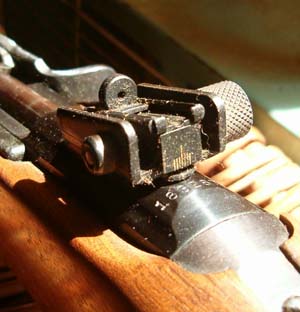
001 The M1 Carbine rear sight is very rugged and fully adjustable.
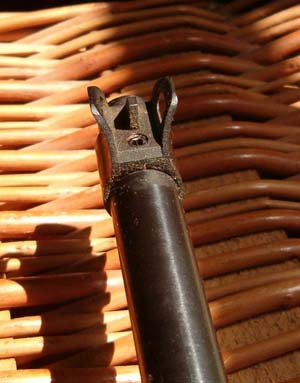
002 The M1 Carbine front sight post is protected by two steel “wings”.
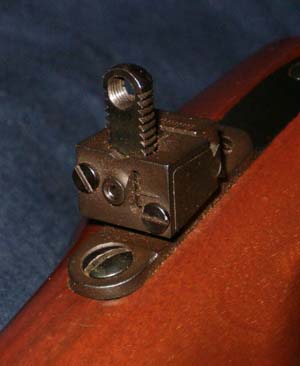
003 This is Thompson/Center’s tang-mounted rear sight on a Renegade muzzle loader.
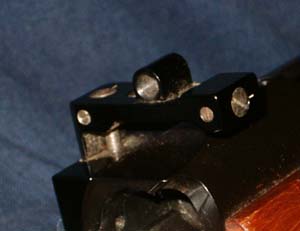
004 Williams FP sight on a Remington 788 action.
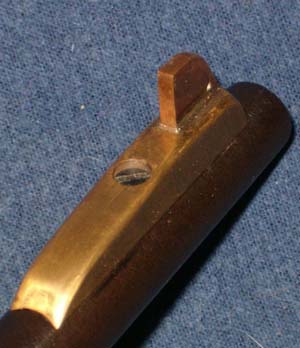
005 A custom brass front post sits atop this Remington barrel.
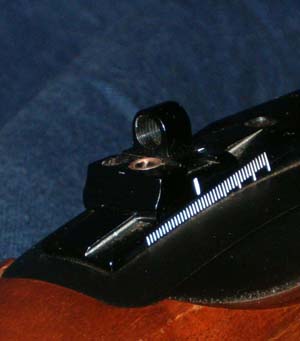
006 Williams GRS on a Ruger 10/22 action.
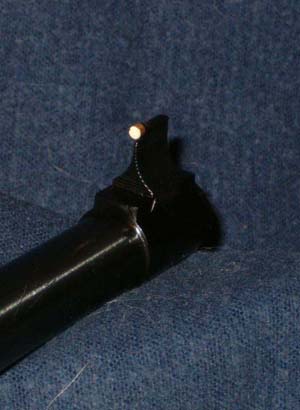
007 Matching Williams front sight on a Ruger 10/22 barrel.
 Last 5 Loads
Last 5 Loads Old Articles
Old Articles
| BP | Bronze Point | IMR | Improved Military Rifle | PTD | Pointed |
| BR | Bench Rest | M | Magnum | RN | Round Nose |
| BT | Boat Tail | PL | Power-Lokt | SP | Soft Point |
| C | Compressed Charge | PR | Primer | SPCL | Soft Point "Core-Lokt" |
| HP | Hollow Point | PSPCL | Pointed Soft Point "Core Lokt" | C.O.L. | Cartridge Overall Length |
| PSP | Pointed Soft Point | Spz | Spitzer Point | SBT | Spitzer Boat Tail |
| LRN | Lead Round Nose | LWC | Lead Wad Cutter | LSWC | Lead Semi Wad Cutter |
| GC | Gas Check |

Copyright © 2024 vBulletin Solutions Inc. All rights reserved.
vBulletin Skins: Len M. Kaiser Web Design






















